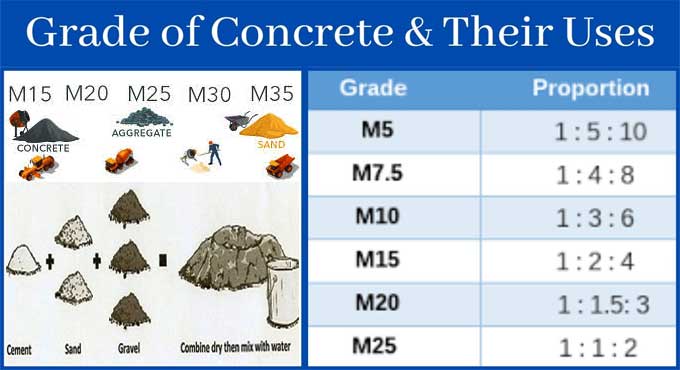NEWS | SOFTWARE | SHEET
Different types of Concrete Grades and their uses
There are many materials used in the construction industry, but concrete is one of the most important. Composed of cement, aggregates, water, and chemicals admixtures, it is a composite material. A wide range of construction projects rely on concrete because of its strength, durability, and versatility.
Concrete quality is determined largely by its strength and durability, both of which are determined by its concrete grade. Depending on the concrete's compressive strength after 28 days of curing, various grades are classified.
M5 Grade Concrete
Concrete of the M5 grade is the weakest and the cheapest. Once it has been curing for 28 days, its compressive strength is 5 N/mm2. In non structural applications, such as plastering, flooring, and leveling, this type of concrete is most commonly used.
M7.5 Grade Concrete
The M7.5 grade concrete has a compressive strength of 7.5 N/mm2 after 28 days of curing, which is a slight increase over M5 grade concrete. Plastering, flooring, and leveling are also performed with this type of concrete.
M10 Grade Concrete
Its compressive strength after 28 days of curing is 10 N/mm2, which is stronger than M7.5 grade concrete. Simple concrete structures, such as sidewalks, footings, and footings, are made from this type of concrete.
M15 Grade Concrete
Small residential construction projects commonly use concrete grade M15. Following 28 days of curing, it has a compressive strength of 15 N/mm2. Generally, this type of concrete is used for foundation walls, beams, and columns that do not require structural strength.
M20 Grade Concrete
There are a number of construction projects that use grade M20 concrete. When cured for 28 days, it has a compressive strength of 20 N/mm2. A foundation wall, column, or beam constructed from this type of concrete is not structural in nature.
M25 Grade Concrete
M25 grade concrete has a compressive strength of 25 N/mm2 after 28 days of curing, which is higher than M20 grade concrete. The type of concrete used in this application is ideal for structural work, such as bridges, high rise buildings, and heavy duty industrial floors.
M30 Grade Concrete
High strength concrete grade M30 is used in heavy construction projects. Once it is cured for 28 days, the compressive strength is 30 N/mm2. Heavy duty industrial floors, bridges, and high rise buildings use this type of concrete.
M35 Grade Concrete
The compressive strength of M35 grade concrete is 35 N/mm2 after 28 days of curing, which is stronger than M30 grade concrete. A durable and strong concrete such as this is often used for heavy duty industrial floors, bridge piers, and other structural uses.
M40 Grade Concrete
Designed for heavy construction projects that require extreme durability and resistance to wear and tear, M40 concrete is the strongest concrete available. When cured for 28 days, it has a compressive strength of 40 N/mm2. Heavy duty structures such as bridge piers and industrial floors use this type of concrete.
M45 Grade Concrete
A concrete grade of M45 is one of the highest strength types of concrete used in construction. The piece has a compressive strength of 45 N/mm2 after curing for 28 days. It is used for heavy duty industrial floors, bridge piers, and other structural projects requiring a heavy duty concrete.
To get more details, go through the following video tutorial.
Lecturer: Engineering Motive
Grades of concrete are determined by the strength of the concrete mix and are used to specify the appropriate mix for a given project.
The higher the grade, the stronger the concrete will be. The use of grade of concrete can help ensure the structural integrity of a building or other structure.

Image Courtesy: buildingourhouse.com

